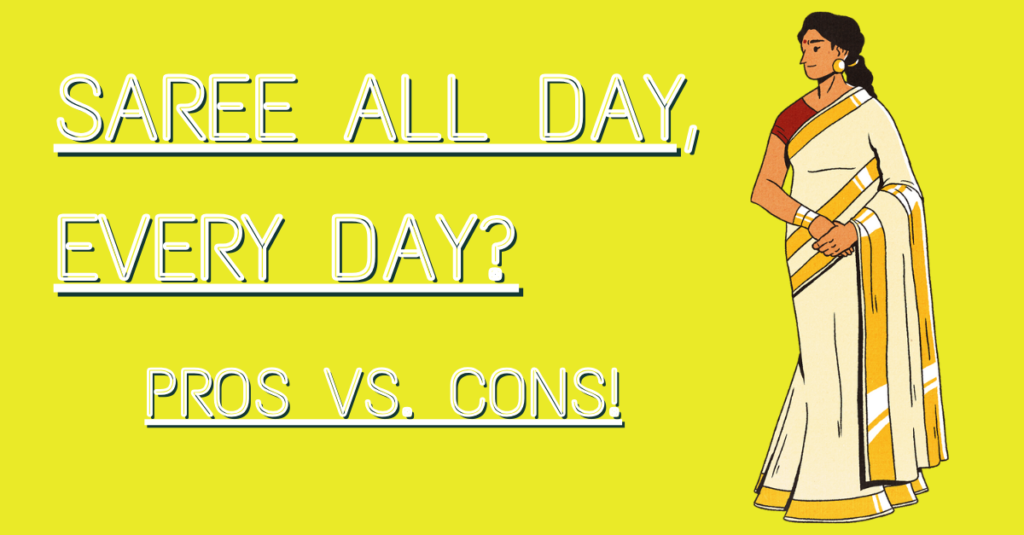Saree All Day, Every Day? Pros vs. Cons!
Introduction
The saree, a quintessential symbol of Indian culture, is not just a garment; it’s a piece of art that weaves together tradition, elegance, and identity. Wearing a saree daily is a practice that has deep-rooted connections to India’s rich heritage, but it also presents a set of unique challenges and considerations in the modern world. In this captivating journey, we will delve into the captivating world of daily saree wearing and explore the myriad of advantages it offers. We’ll uncover the timeless elegance it bestows upon wearers, the cultural significance that binds it to our hearts, and the environmental consciousness it fosters.
However, it’s not all glamour and grace. We’ll also shed light on the practicalities – the time, effort, and expense involved in maintaining this tradition, as well as the weather-related hurdles. Join us as we unravel the age-old question: Is wearing a saree every day worth it? This is a candid exploration of the saree, a beloved cultural emblem, and the contemporary considerations that come with it.
-
Pros of Wearing a Saree Every Day

1. Elegance and Grace
One cannot deny the sheer elegance and grace that a saree bestows upon the wearer. The six to nine yards of fabric, draped artfully, can transform anyone into a vision of beauty and poise. The saree accentuates the curves and contours of the body while leaving much to the imagination, making it a garment that exudes sophistication and sensuality.
The saree’s timeless appeal is such that it suits women of all ages, from young girls to elderly ladies. It adapts to the body, enhancing the natural beauty of the wearer. The feel of the soft fabric against the skin and the gentle swish as one walks all contribute to an unparalleled sense of elegance and confidence.
2. Versatility in Design
One of the most remarkable aspects of sarees is their diversity in design. From the intricate handwoven silk sarees of South India to the vibrant and lightweight cotton sarees of the North, there’s a saree for every occasion and mood. You can choose from a wide range of colors, patterns, and fabrics to match the setting and your personal style.
A single saree can be draped in numerous ways, each style reflecting a unique cultural and regional influence. This versatility allows you to express your individuality and adapt your look for various events, whether it’s a casual day at home or a grand wedding celebration.
3. Cultural Connection
Wearing a saree daily establishes a profound cultural connection. In India, the saree is more than just clothing; it’s a symbol of heritage and identity. It’s a way of paying homage to the rich tapestry of Indian culture, with each region and community contributing its own unique style and techniques to the world of saree design.
For many, wearing a saree daily is a way of preserving and celebrating their cultural roots. It’s a visible link to generations past and a powerful expression of pride in one’s heritage. It fosters a sense of belonging and continuity in a rapidly changing world.
4. Comfort and Breathability
Contrary to the assumption that sarees are uncomfortable, many women find them surprisingly comfortable, especially in hot and humid climates. The saree allows for better air circulation, keeping the body cool and preventing the discomfort associated with tight-fitting Western attire. Additionally, the loose drape of the saree provides freedom of movement, making it an excellent choice for daily wear.
The soft, breathable fabrics used in saree production, such as cotton and silk, add to the comfort factor. This makes sarees not only elegant but also practical for everyday activities.
5. Environmental Sustainability
In an era of fast fashion and disposable clothing, traditional saree production stands out as a beacon of sustainability. Handwoven sarees, made using age-old techniques, consume fewer resources and produce less waste compared to mass-produced garments. Additionally, the longevity of a well-maintained saree can extend over generations, reducing the need for constant replacements.
By choosing to wear sarees daily, individuals can promote sustainable fashion choices and contribute to the preservation of traditional craftsmanship, which is often threatened by modern industrial practices.
-
Cons of Wearing a Saree Every Day

1. Time-Consuming
Draping a saree with precision is an art that requires time and practice. For those who are not accustomed to it, the process can be time-consuming. In the fast-paced world of today, finding the extra minutes needed to drape a saree daily can be challenging, especially for working women with busy schedules.
While some women may consider the act of draping a saree a therapeutic and enjoyable ritual, others might find it a hindrance to their daily routines.
2. Mobility and Convenience
Wearing a saree can limit mobility and convenience, particularly in modern urban settings. The long trail of fabric can pose difficulties when climbing stairs, getting in and out of vehicles, or simply moving swiftly. Activities that require agility, such as sports or quick movements, can be hampered by the saree’s design.
Additionally, wearing a saree daily might not be practical for professions that demand a high degree of physical activity, where comfort and ease of movement are paramount.
3. Expense
Investing in quality sarees can be costly, especially when considering the variety of designs and fabrics available. Handwoven silk sarees, for example, can come with a hefty price tag. Moreover, maintaining these delicate garments requires proper care, which may include dry cleaning and storage in specific conditions.
For individuals on a tight budget, the expense associated with owning multiple sarees and keeping them in good condition can be a significant drawback.
4. Cultural Restrictions
In some communities and regions of India, societal expectations place considerable pressure on women to wear sarees daily. This expectation can limit personal choice and individual expression, as some women may prefer other types of clothing for comfort or practicality.
It’s essential to recognize that clothing should be a matter of personal choice and comfort, rather than something dictated by societal norms or traditions.
5. Weather Sensitivity
While sarees are comfortable in warm climates due to their breathability, they can be challenging to manage in extreme weather conditions. Rain and mud can quickly damage the delicate fabric, and wearing a saree in extremely cold weather can be uncomfortable unless layered appropriately. This weather sensitivity can be a significant concern for those who need to navigate diverse climates.
Conclusion
In the age-old debate of whether to wear a saree every day, the answer is not a one-size-fits-all. It depends on personal preferences, lifestyle, and circumstances. The saree, with its timeless elegance, cultural significance, and sustainability, holds a special place in the hearts of many. However, it’s essential to acknowledge the practical challenges, such as time constraints, mobility issues, and expenses, that come with daily saree wear.
Ultimately, the decision to wear a saree every day should be a matter of personal choice. It’s about celebrating the beauty of this traditional attire while also recognizing the need for practicality and comfort in our modern lives. Whether one chooses to drape a saree daily or only on special occasions, the essence of the garment and its cultural significance remain undiminished, making it a cherished part of India’s heritage.

My name is Rohit Vagh and I’m a content writer specializing in fashion and lifestyle. I have three years of experience in this field and have written various articles. My writing style is creative and engaging, and I strive to create content that resonates with my readers. I have a deep passion for fashion and am constantly researching the latest trends and styles to make sure my readers are up to date. I’m excited to continue my career in blogging, and I’m always looking for new opportunities in the fashion and lifestyle space.





